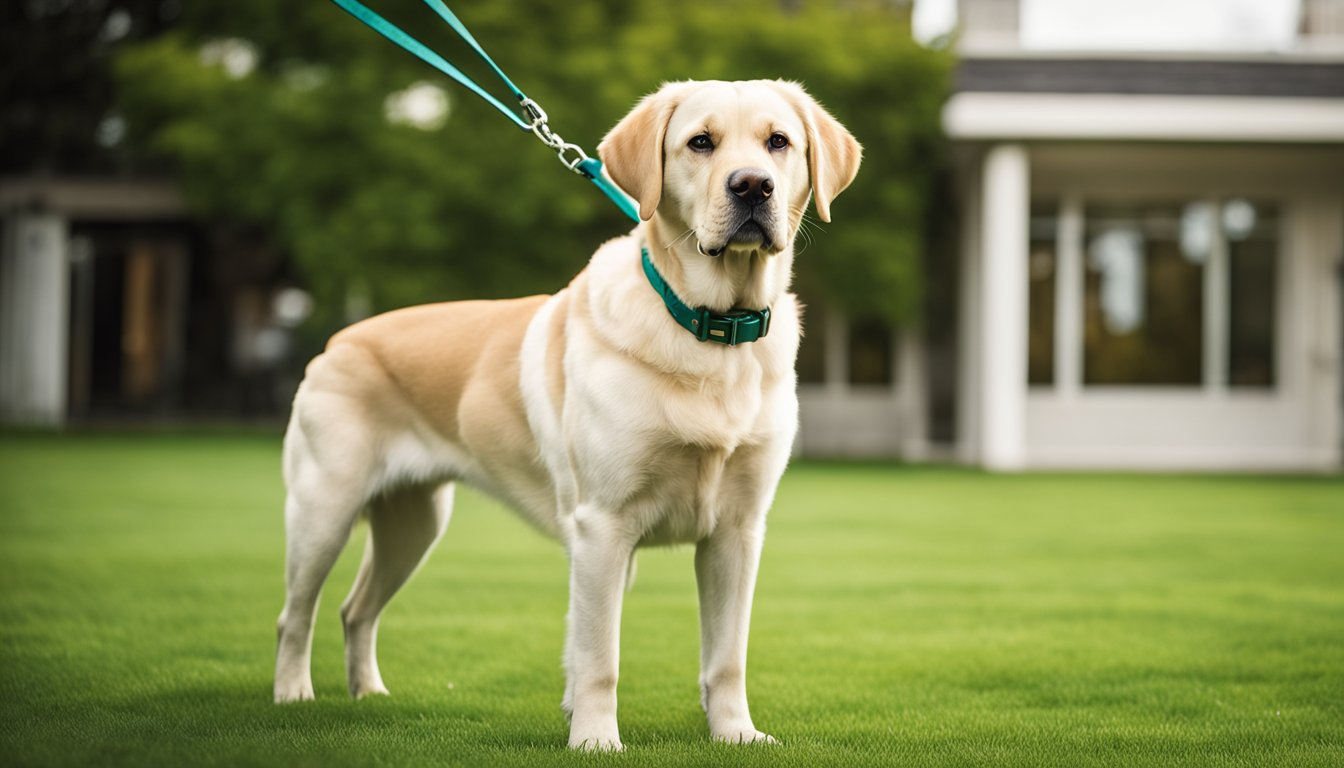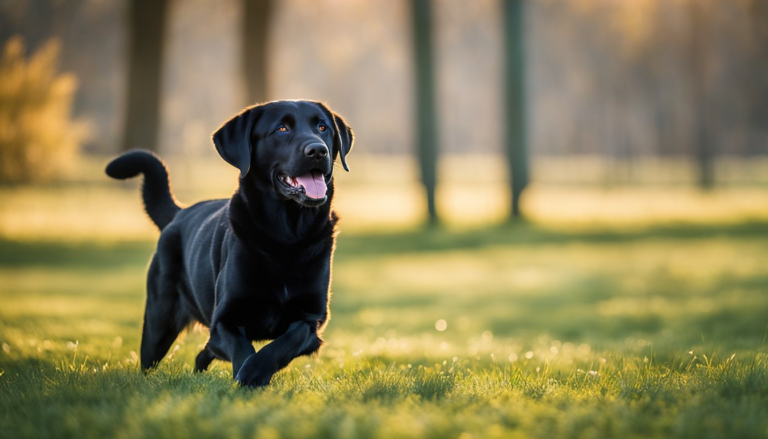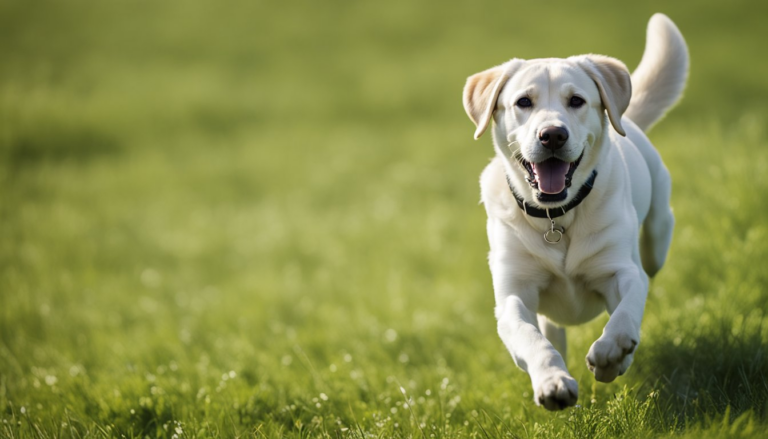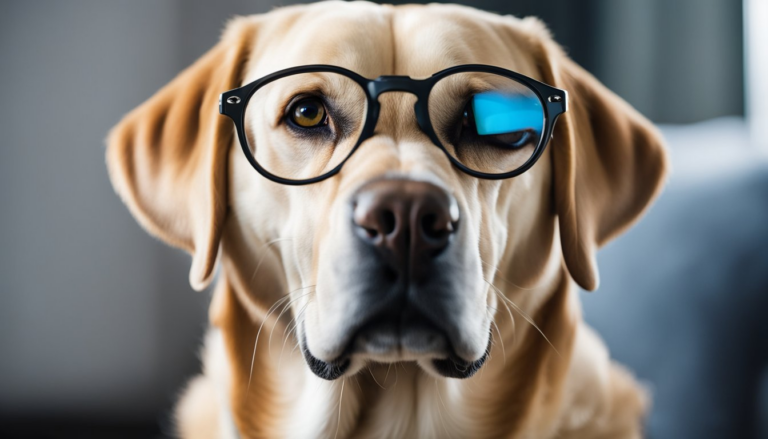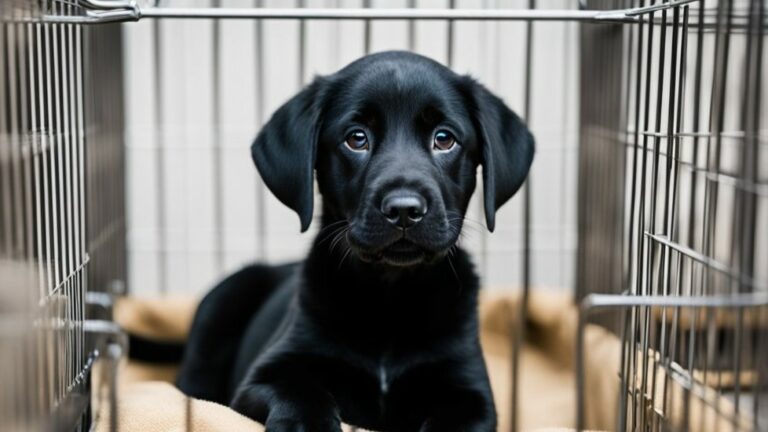How to Potty Train a Labrador Retriever Puppy: Expert Tips and Tricks
Potty training a Labrador Retriever puppy can seem like a daunting task, especially for first-time dog owners. However, with consistency, patience, and a good understanding of the breed’s typical behavior, it is entirely possible to successfully house-train your Labrador puppy.
Before beginning the potty training journey, it is necessary to gather supplies such as a crate, treats, and a leash while also dedicating time and attention to your pup’s needs.
Labrador Retrievers are known for their intelligence and eager-to-please attitude, making them highly trainable. By using effective training techniques tailored to your puppy’s developmental stages, you can establish a strong foundation for potty training. It is also important to address and prevent accidents, manage night-time potty training, and help your dog learn to be comfortable in various public places to ensure success.
Key Takeaways
- Proper preparation and understanding of Labrador puppy behavior are pivotal for successful potty training.
- Consistency, effective training techniques, and accident prevention strategies contribute to the overall success of the process.
- Recognizing milestones and overcoming common challenges will support your puppy’s progress and build a strong foundation for their ongoing development.
Preparation for Potty Training
Selecting an Appropriate Potty Spot

When potty training your Labrador Retriever puppy, it is important to select an appropriate potty spot outdoors. Choose a spot that is easily accessible, close to the door, and has an area where your puppy can sniff and explore his surroundings. Ideally, it should be a designated area with a clear boundary, such as a patch of grass or a corner in your yard.
Picking a consistent spot will help your puppy associate that location with relieving itself, ultimately speeding up the potty training process.
The Importance of a Consistent Feeding Schedule
Establishing a consistent feeding schedule is another key element in potty training your Labrador puppy. Providing meals at the same time each day helps regulate your puppy’s digestion and bowel movements. Consequently, it makes predicting when they will need to go potty easier.
Ideally, young pups should be fed at least three times a day until they reach six months old. Once they reach six months, reduce the frequency to twice daily. Remember to monitor the portion sizes and adjust them as your puppy grows.
List of Essential Supplies
Having the right training supplies on hand will significantly improve the potty training experience for both you and your Labrador puppy. Below is a list of required items you’ll need to start potty training:
| Supply | Purpose | Tips |
| Puppy pads | Training your puppy to go potty in a designated area indoors. | Gradually phase out as your puppy gets used to going outside. |
| Cleaning agents | Removing stains and odors from accidents. | Choose pet-safe solutions. |
| Treats | Rewarding your puppy after successfully going potty outside. | Use small, tasty treats that are specifically meant for training. |
By following these guidelines and preparing yourself with the necessary equipment and knowledge, you will set the foundation for a smooth and efficient potty training process. Remember to be patient and consistent, as every Labrador Retriever puppy will learn at its own pace.
Understanding Labrador Puppy Behavior
Recognizing the Tell-Tale Signs Your Puppy Needs to Relieve Itself
Labrador puppies, like all puppies, give off signals when they need to relieve themselves, a behavior that’s been studied in the context of Optimising Puppy Socialisation–Short- and Long-Term Effects of a Training Programme during the Early Socialisation Period. Understanding these signals is crucial for effective potty training. In general, lab puppies will sniff the ground, walk in circles, or start whining when they need to go.
If you notice these behaviors, it’s required to take your puppy outside promptly. Reacting quickly to these signals will help train your Labrador puppy to associate outside with relieving themselves.
In addition to recognizing when your puppy needs to go, it’s pivotal to be proactive. One way to do this is by teaching your puppy to pee on command. To do this, say a specific word or phrase when you take your puppy outside to potty, such as “go pee.”
Over time, your puppy will associate the command with the action, making it easier to control when and where they relieve themselves.
Key Moments When Puppies Typically Need to Go
Being aware of specific times when your labrador puppy is more likely to need to relieve themselves helps in potty training. Puppies generally have to pee and poop:
- After waking up
- After eating or drinking
- After playing or exercise
- Before bedtime
By taking your lab puppy outside during these key moments, you increase the likelihood of catching them before they have an accident inside. Consistency is necessary, so stick to a routine as much as possible and ensure everyone in the household follows the same plan.
Understanding Labrador puppy behavior is necessary for successful potty training. By recognizing the signals they give when they need to relieve themselves and knowing key moments when they typically need to go, you will be more effective in teaching your lab puppy where and when to do their business.
Effective Training Techniques
The Role of Consistency in Successful Potty Training
Consistency plays a significant role in successfully potty training a Labrador retriever puppy, as highlighted in research on Dog training methods: their use, effectiveness, and interaction with behavior and welfare. By creating a regular schedule for feeding and bathroom breaks, puppies are more likely to develop good habits and learn when it’s the appropriate time to eliminate. The approach owners take in training their dogs can be influenced by various factors, as highlighted in research on factors influencing dog training approaches.
That means sticking to a routine where you take them out first thing in the morning, after meals, and before bed.
As these intelligent dogs thrive on consistency, don’t change the designated potty area frequently. Always take them to the same spot, and use the same command to encourage faster learning and avoid confusion.
Positive Reinforcement: Why It Works and How to Do It
When it comes to potty training, using positive reinforcement has proven to be highly effective. This technique involves praising and rewarding your puppy when they successfully eliminate outside. By doing so, you reinforce their good behavior and encourage them to repeat it in the future.
To ensure optimal results, offer your Labrador puppy a tasty treat as soon as they finish pottying and verbally praise them. Over time, the association between doing their business outside and receiving rewards will strengthen and lead to a well-potty-trained pet.
The Use of Command Words and Their Effectiveness
Using voice commands consistently during potty training can significantly speed up the process, as it helps your Labrador retriever puppy understand what’s expected of them. Choose a specific command, such as “Go Potty” or “Do Your Business” and stick to it each time you take your puppy out to eliminate.
Labradors are known for their intelligence and capacity for self-control, making them particularly responsive to voice commands. By pairing the command with the action, your puppy will quickly learn the connection and eliminate it when asked.
An Introduction to Crate Training and Its Benefits
Crate training is an excellent method to effectively potty train your Labrador puppy while providing them with a safe and comfortable space. Since dogs are naturally den animals, they tend to avoid eliminating where they sleep, making crate training an ideal solution for potty training.
To successfully implement crate training, choose a crate that’s just large enough for your puppy to stand up, turn around, and lie down in. Remember not to leave your puppy in the crate for too long – take them out regularly for potty breaks and exercise.
By combining crate training with the other techniques mentioned above, such as consistency, positive reinforcement, and command words, potty training your Labrador retriever puppy will be a smooth and efficient process.
Addressing and Preventing Accidents
Appropriate Reactions to Indoor Accidents
When house-training a Labrador retriever puppy, accidents are bound to happen. It is important to react appropriately to these incidents. Instead of scolding or punishing the puppy, simply interrupt them with a neutral tone, such as saying “uh oh” or “oops.” Then, lead them outdoors or to their designated elimination area to finish the process. Praise and reward them when they successfully complete the task in the correct place.
Effective Cleaning Methods to Deter Repeat Offenses
Keeping the indoor environment clean and free of lingering odors is great for successful house training. When a puppy has an accident, it is needed to clean the area thoroughly with an enzymatic cleaner, designed to break down and eliminate urine and feces molecules. This prevents the puppy from being attracted to the same spot for future eliminations. Be sure to follow the directions on the cleaner’s label for optimal results.
Cleaning Method and Benefit
- Enzymatic cleaner effectively breaks down and removes odors from urine and feces.
- Blotting helps remove liquid without pushing it further into the surface.
- Air Drying allows the cleaner to fully penetrate and neutralize odors.
Also, washing any soiled washable items, such as bedding or toys, will further discourage the association between accidents and specific locations.
Emphasizing That Accidents Are a Natural Part of the Learning Curve
Setbacks in indoor potty training are normal and should be expected during the learning process. Remember that a Labrador retriever puppy is still developing and may not have full control over their elimination habits. Patience, consistency, and a positive attitude will go a long way in helping your puppy learn the desired behavior.
Keep track of your puppy’s progress, and make adjustments to their routine and supervision as needed. Reinforce their positive behaviors with praise and rewards, and remain supportive and encouraging throughout the house-training journey.
Strategies for Night-Time Potty Training
Establishing and Sticking to a Bedtime Routine

Developing a consistent bedtime routine is significant in teaching your Labrador retriever puppy to hold on at night. The routine should include feeding your puppy at the same time every evening, followed by a walk or playtime to help with digestion. After that, settling them down for the night becomes important.
Establish a designated sleep area for your puppy and make it comfortable, which will contribute to a better night’s sleep.
A calm bedtime routine also helps your puppy understand when it’s time to sleep. This includes turning off any distractions and providing a dark, quiet environment. Consistency is the key; following this routine every night will help your puppy learn to associate the routine with bedtime.
Managing Your Puppy’s Water Intake in the Evening
Controlling your pup’s water intake in the evening can help reduce the chances of nighttime accidents. While Labrador retrievers need to stay hydrated, you should monitor and limit their water consumption right before bedtime. Providing water earlier in the evening and then ensuring they have ample opportunities to eliminate before bedtime will help prevent accidents during the night.
However, it’s important to remember that puppies are individuals, and their needs may vary. Adjust the management of your puppy’s water intake based on their specific requirements while still ensuring they stay properly hydrated.
The Role of Alarms or Scheduled Wake-Ups in Preventing Accidents
Using alarms or scheduled wake-ups can play a significant role in preventing accidents during the night. Puppies have smaller bladders and may need to go out more frequently, so setting an alarm to wake up in the middle of the night to take your puppy out for a quick potty break is a helpful strategy. This will not only prevent accidents but also reinforce their understanding of the desired behavior.
In addition, scheduling frequent potty breaks during the day can aid in your puppy’s overall potty training regimen. Encourage naps in between playtime and potty breaks to ensure your pup associates their designated sleep area with resting.
Patience is required when potty training a Labrador retriever puppy, especially during the nighttime. Remember that accidents may happen regardless of your efforts, but with consistency, attentiveness, and patience, your puppy will learn to hold it in through the night.
Overcoming Common Challenges
Identifying and Addressing Common Potty Training Challenges
One of the main challenges faced when trying to potty train a Labrador retriever puppy is maintaining consistency. It’s nice to establish a regular schedule for taking the puppy outside to eliminate it. Set specific times throughout the day for potty breaks, and gradually increase the time between breaks as your puppy begins to understand the routine.
Remember to always praise and reward them when they succeed in going potty outdoors.
Stubbornness might also be an issue, but this can be tackled through patience and persistence. If accidents happen indoors, it’s important not to scold your puppy. Instead, calmly clean up the mess and continue the training process.
To minimize indoor accidents, try to identify your puppy’s patterns and signs, such as sniffing or circling, and promptly take them outside when you notice these behaviors.
Managing distractions can be another hurdle in potty training, as Labrador retrievers are often social and energetic puppies. When taking your puppy outdoors for a potty break, keep them on a leash and guide them to a designated potty area to help maintain focus. Establish the location as the primary potty spot, so your puppy begins to associate the area with eliminating waste.
Adapting Training Techniques for Inclement Weather
Weather is an important factor to consider during house training, as unfavorable weather conditions can influence your puppy’s willingness to go outside. In the case of heavy rain, snow, or extreme temperatures, Labrador retrievers may be reluctant to go outdoors.
To combat this issue, it can be helpful to create a temporary potty area indoors. Choose a location away from your puppy’s sleeping and eating spots. Use puppy pads or a designated area with a waterproof surface where your puppy can go if the weather does not permit.
Another approach would be to gradually acclimate your puppy to various weather conditions. Particularly during light rain or snow, take your puppy outside for short potty breaks to familiarize them with the conditions. Encourage and praise your puppy when they successfully eliminate outdoors in inclement weather.
Taking the time to assess and respond to these common challenges will significantly improve the potty training process for your Labrador retriever puppy. Through consistency, patience, and adaptability, you will set your puppy on the path to becoming a well-house-trained companion.
Socialization and Training in Public Places

Labrador Retrievers are a popular dog breed known for their intelligence, playfulness, and eager-to-please temperament. Socialization and potty training are key aspects of raising a well-adjusted and well-behaved Lab puppy. This section will discuss tips and techniques for potty training during outings and introducing your Lab puppy to dog-friendly public areas.
Tips for Potty Training During Outings
- Plan your outings: Choose locations where you have access to designated potty break areas. This can make it easier for your puppy to understand where it’s appropriate to go.
- Use a consistent command: Choose a command, such as “go potty,” and use it consistently when you want your Lab puppy to relieve itself outdoors.
- Reward success: Positive reinforcement is necessary for successful potty training. Reward your Lab puppy with praise, treats, or playtime when they successfully go potty in the designated area.
- Routine: Establish a schedule for potty breaks during outings, which can help your puppy understand that specific times are for bathroom breaks.
- Patience: Remember that accidents can happen, especially during the early stages of potty training. Be patient and consistent in your approach.
- Monitor vaccine status: Make sure your Lab puppy has received all necessary vaccinations before venturing into public spaces where they may come into contact with other dogs and potential pathogens.
Introducing Your Puppy to Dog-Friendly Public Areas
Introducing your Lab puppy to dog-friendly public areas is an important part of socialization, as it helps them gain confidence and develop appropriate behaviors in a variety of settings.
- Start small: Begin by introducing your Lab puppy to quieter outdoor areas, where they can explore without becoming overwhelmed or intimidated.
- Gradually increase exposure: As your puppy becomes more confident, expose them to larger and busier public spaces, but always monitor their comfort level.
- Encourage playtime: Arrange playdates with other dogs in public spaces to give your Lab puppy opportunities to socialize with different breeds and personalities.
- Obedience training: Teach your Lab puppy basic obedience commands such as “sit,” “stay,” and “come,” which can be helpful in managing their behavior in public places.
- Leash training: Ensure your Lab puppy is comfortable and well-behaved on a leash before exposing them to new environments, as this helps maintain control and ensures their safety.
- Respect others: Be mindful of other people and dogs in public spaces, making sure your Lab puppy does not become a nuisance or cause disruptions.
Celebrating Progress and Recognizing Milestones
How to Acknowledge and Reward Small Victories

When potty training a Labrador retriever puppy, it’s required to acknowledge and reward small victories. To do this, offer your puppy praise, love, and occasional treats when they successfully use the designated potty area. This can help to reinforce good behavior and make the training process more enjoyable for both you and your pup.
Remember that patience is key, as each puppy will progress at their own pace, and it’s important to set realistic expectations.
Signs That Your Training is on the Right Track
It’s important to recognize the milestones your Labrador retriever puppy reaches during the potty training process. Some signs that your training is on the right track include:
- Consistently using the designated potty area
- Signaling or showing signs of needing to use the bathroom (e.g., sniffing, circling, or whining)
- Gradual reduction in the number of accidents inside the house
These positive changes indicate that your puppy is understanding the expectations and becoming more potty trained with time.
Adjusting Your Approach as Your Puppy Matures
As your Labrador retriever puppy goes through different stages of growth, you may need to adjust your potty training approach. Below are some common adjustments:
- Increasing the time between bathroom breaks: As your puppy grows older, they will gain better control over their bladder and bowel movements, and you can gradually increase the time between potty breaks.
- Reinforcing good habits: As your puppy becomes more familiar with the potty training routine, continue to reward them for good behavior to reinforce positive habits.
- Re-evaluating your puppy’s diet: As your Labrador retriever puppy matures, their dietary needs may change, which can impact their bathroom habits. Consult your veterinarian to ensure your puppy is receiving the appropriate food and portion sizes for their age and size.
Using these strategies, you can ensure that your Labrador retriever puppy’s potty training experience is successful and tailored to their individual growth and development.
Frequently Asked Questions
How to train a Lab puppy for bladder control?
To train a Labrador puppy for bladder control, start by establishing a consistent routine for taking your puppy outside to eliminate. Choose a designated potty area and always take your puppy to this spot during potty breaks. Praise and reward your puppy when they successfully eliminate outside.
Limit access to water and food before bedtime to reduce the chances of accidents during the night. If your puppy has an accident indoors, clean it thoroughly to remove any lingering smells that might encourage repeat behavior.
What is the ideal age to start toilet training a Labrador?
The ideal age to start toilet training a Labrador is around 8-12 weeks old. At this age, puppies begin to develop better bladder and bowel control, which makes it easier for them to learn and adapt to potty training routines. Puppies at this age are also more receptive to training cues and rewards, which will aid in the potty training process.
What are the best strategies for potty training a Labrador without a crate?
Potty training a Labrador without a crate involves close monitoring and consistent routines. Keep your puppy on a leash when indoors so you can always observe their behavior. Look for signs that your puppy needs to go, such as sniffing the floor, circling, or whining.
Take your puppy outside to the designated potty area at regular intervals, especially after eating, playing, or waking up from a nap. Establish a routine and praise your puppy when they eliminate at the desired spot.
How to manage a Lab puppy’s excitement during potty training?
To manage your Labrador puppy’s excitement during potty training, try to remain calm and consistent in your approach. Use a gentle, firm tone when giving commands and choose a specific cue, like “go potty” or “outside.” Reinforce positive behavior with treats and praise, but avoid overdoing it, as this will contribute to excitement.
If your puppy becomes overly excited, take a break and try again later, maintaining your patience throughout the process.
Why is my Labrador puppy peeing indoors despite potty training?
Labrador puppies may pee indoors despite potty training for several reasons. These can include incomplete training or lack of consistency during the training process, a medical issue such as a urinary tract infection, anxiety or stress, or simply the puppy’s age since bladder control takes time to master. If you suspect a medical issue, consult a veterinarian.
Otherwise, revisit the potty training steps and continue to reinforce positive behavior in a consistent manner.
Are there proven methods to toilet-train a puppy in a week?
While some puppies may show significant progress in a week, it is required to understand that potty training is a process that may take longer for some individuals. The key to successful potty training is consistency, patience, and positive reinforcement. The more time and effort you put into potty training, the better the results will be.
With persistent training, many puppies can be reliably potty trained in a few weeks, but remember that each dog is different, and there may be occasional accidents.

